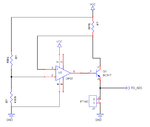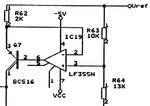Ranbeer Singh
Full Member level 5

- Joined
- Jul 30, 2015
- Messages
- 259
- Helped
- 22
- Reputation
- 44
- Reaction score
- 22
- Trophy points
- 1,298
- Location
- Faridabad India
- Activity points
- 3,266
Hello
I am making 1ma current source for constant
- - - Updated - - -
Sorry for mistake
Continue......I am making 1ma constant current source for PT100 sensor using OP07 op-amp. I am using a voltage divider for negative pin and a series resistance for positive input pins. At the negative input pin i am generating 4.57V and same on positive pin by a 501E resistance it will drop approximately 0.5V. Same volt at both inputs... and transistor should be generate 1ma constant current.
It's not working according my calculation. When i connect 100E resistance it makes 115mv.
V=I*R
0.001*100 = 0.1v
But it's generating 0.115v. Please help...circuit is given below.
Circuit
https://obrazki.elektroda.pl/9844962300_1455512660.png
I am making 1ma current source for constant
- - - Updated - - -
Sorry for mistake
Continue......I am making 1ma constant current source for PT100 sensor using OP07 op-amp. I am using a voltage divider for negative pin and a series resistance for positive input pins. At the negative input pin i am generating 4.57V and same on positive pin by a 501E resistance it will drop approximately 0.5V. Same volt at both inputs... and transistor should be generate 1ma constant current.
It's not working according my calculation. When i connect 100E resistance it makes 115mv.
V=I*R
0.001*100 = 0.1v
But it's generating 0.115v. Please help...circuit is given below.
Circuit
https://obrazki.elektroda.pl/9844962300_1455512660.png




